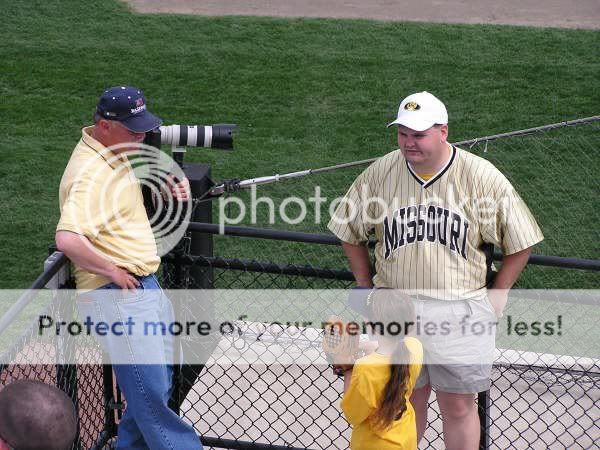 |
| Rollins Field, 1954 On the back side of the MU football field |
I'm really quite pleased with Taylor Stadium. A great deal of my satisfaction with the current stadium comes from the fact that I spent many years watching the Tigers in the old ballpark.
 |
| Simmons Field "grandstand" and press box, mid 1990s |
The capacity of Simmons Field was around 2,000. The press box was a cramped collection of booths not much larger than a closet. The stairway leading to the press box was a hazard to life and limb. The men's restroom (I was never in the women's) featured a single toilet, a communal trough-style urinal, a single small sink and an electric plug-in space heater. For larger crowds they brought in a couple of port-a-potties.
 |
| Simmons Field 1960s |
All of the seating in Simmons Field was on aluminum bleachers, with open air between the seat and the foot rest. Considering the ballpark was built on one of the highest elevations in Columbia, at the top of a steep hill (see The Summit, below), the wind would whip through Reactor Field at the bottom of the hill, rush northeast up toward the ballpark and, unhindered by any walls or enclosed bleachers, would deliver a constant chilling breeze (or gale) upon the seated patrons, maintaining the aluminum seating at a chilled temperature, and turn the playing field itself into a wind tunnel that produced some incredible wind blown home runs.
 |
| Taylor Stadium crowd |
The capacity is expanded now to around 3,500. The front row seating is closer to the foul lines and home plate than before. There are 537 bucket-style chair-back seats in the lower sections. The rest are bleacher style - enclosed bleachers.
The walls around the sub-seating area baseball office, concessions, restrooms (heated), and home club house serve as more of a wind break than the previous wide-open construction did.
 |
| Simmons Field seen from Taylor Stadium press box |
Of course, D-1 Baseball has changed, and now there are more and more college ballparks that are built more like a Double-A Minor League park (many of them ARE minor league parks).
The average attendance at SEC games in 2012 was larger than the maximum capacity of Taylor Stadium.
 |
| Taylor Stadium Photo digitalballparks.com |
The Columbia Tribune reported in June on MU facility improvements specified in document
The University of Missouri will request approval of $72 million worth of athletic facility improvements at tomorrow's meeting of the UM Board of Curators in Columbia.The article includes a link to the actual MU Facility Improvement document. Here are the sections of that document speaking directly about Taylor Stadium renovations:
The University of Missouri-Columbia requests approval of Bond Financed Intercollegiate Athletics Projects totaling $72 million and Architect Selection for the Memorial Stadium East Side Addition and the West Side Press Box Renovation. The $72 million in debt financing will fund the Memorial Stadium Est Side Addition, the Memorial Stadium West Side Press Box Renovation and six small projects and are described below in three sections.Mizzou Network has a video interview with Coach Tim Jamieson about the expansion plans. Check out the video . . . and check out Tim Jamieson's personal renovation in preparation for the SEC, growing what appears to be a Colonel Sanders beard and mustache.
. . .
Section 3 of the Document: There are six other projects, each less than $5 million project cost funded by the remaining $16,175in revenue bonds:
Taylor Stadium Renovation will include the addition of team lockers-players' lounge, toilets-showers-sinks, additional storage and three coaches' offices to the McArtor Baseball Facility. Spectator field boxes are planned to be added along the third base line.
♦ The Summit
There is a hill behind Taylor Stadium in Columbia, Mo. The beast is located in line with home plate, parallel to Providence Road. It is so steep that, on game days, Missouri athletic department officials use golf carts to shuttle fans to the gates from parking lots below. It is a place Missouri baseball players want to avoid. The Summit makes them pay. Future major league pitchers who struggled with their command were sent there. Players with sagging body language, too. They had to sprint the brutal incline in 27 seconds "It's a hard 27 seconds," said Tony Vitello, former Missouri pitching coach as they toiled over their mistakes with calves burning like a brush fire. A typical date with the monster lasted six to eight repetitions. Some went 20. One was enough. "It sucked," said former Missouri pitcher Aaron Crow, now in his first year with the Kansas City Royals. "It was not fun."
. . .
The hill brings them back. Though Scherzer, Crow and Gibson have moved onto mounds under brighter lights, their time spent on the Summit has marked them. The lessons will never leave. "If you were falling behind hitters, you ran the hill," Scherzer said. "It enforced the importance of working ahead against hitters, because that makes you successful." Said Crow: "One time, when I was a freshman, I was supposed to run 15 or 16. I quit after 12." Added Gibson with a laugh: "I think that was half my motivation to sign after my junior year." Success binds Missouri's pitching lineage. Drive and discipline connect the players forever. (Yard Barker)

.JPG)
.JPG)















